Dictyostelium Differentiation-Inducing Factor 1 Promotes Glucose Uptake via Direct Inhibition of Mitochondrial Malate Dehydrogenase in Mouse 3T3-L1 Cells
Abstract
1. Introduction
2. Results
2.1. Effects of DIF-1, DIF-3, and THPH on the Growth of HeLa and 3T3-L1 Cells and Glucose Uptake in 3T3-L1 Cells
2.2. Identification of DBPs in HeLa and 3T3-L1 Cells
2.3. Effects of an MDH2 Inhibitor on the Growth of HeLa and 3T3-L1 Cells and on Glucose Uptake in 3T3-L1 Cells
2.4. Combinatorial Effects of LW6, Dinitrophenol, and 8-bromo-cAMP on Glucose Uptake in 3T3-L1 Cells
2.5. Effects of LW6, DNP, and Br-cAMP on AMPK Activity in 3T3-L1 Cells
3. Discussion
3.1. DIF-1 and DIF-3 as Leads for the Development of Anticancer and/or Antidiabetic Drugs
3.2. Mechanism of the Action of DIF-1 to Promote Glucose Uptake: Pharmacological Target of DIF-1
4. Materials and Methods
4.1. Cells and Reagents
4.2. Assessment of Glucose Consumption (Uptake) in 3T3-L1 Cells
4.3. Cell Growth Assay
4.4. Coupling of DIF-1-NH2 and Affi-Gel 10 Resin
4.5. Identification of DBPs in HeLa and 3T3-L1 Cells
4.5.1. Preparation of Cell Extracts for Affinity Chromatography
4.5.2. Affinity Chromatography and SDS-PAGE
4.5.3. LC–MS/MS
4.6. Western Blotting
4.7. Statistical Analyses
5. Conclusions
Author Contributions
Funding
Institutional Review Board Statement
Informed Consent Statement
Data Availability Statement
Acknowledgments
Conflicts of Interest
References
- Morris, H.R.; Taylor, G.W.; Masento, M.S.; Jermyn, K.A.; Kay, R.R. Chemical structure of the morphogen differentiation inducing factor from Dictyostelium discoideum. Nature 1987, 328, 811–814. [Google Scholar] [CrossRef]
- Morris, H.R.; Masento, M.S.; Taylor, G.W.; Jermyn, K.A.; Kay, R.R. Structure elucidation of two differentiation inducing factors (DIF-2 and DIF-3) from the cellular slime mould Dictyostelium discoideum. Biochem. J. 1988, 249, 903–906. [Google Scholar] [CrossRef] [PubMed]
- Kay, R.R.; Berks, M.; Traynor, D. Morphogen hunting in Dictyostelium discoideum. Development 1989, 107, 81–90. [Google Scholar] [CrossRef] [PubMed]
- Kay, R.R.; Flatman, P.; Thompson, C.R.L. DIF signalling and cell fate. Semin. Cell Develop. Biol. 1999, 10, 577–585. [Google Scholar] [CrossRef]
- Gokan, N.; Kikuchi, H.; Nakamura, K.; Oshima, Y.; Hosaka, K.; Kubohara, Y. Structural requirements of Dictyostelium differentiation-inducing factors for their stalk-cell-inducing activity in Dictyostelium cells and anti-proliferative activity in K562 human leukemic cells. Biochem. Pharmacol. 2005, 70, 676–685. [Google Scholar] [CrossRef] [PubMed]
- Kubohara, Y.; Kikuchi, H.; Matsuo, Y.; Oshima, Y.; Homma, Y. Mitochondria are the target organelle of differentiation-inducing factor-3, an anti-tumor agent isolated from Dictyostelium discoideum. PLoS ONE 2013, 8, e72118. [Google Scholar] [CrossRef]
- Takahashi-Yanaga, F.; Yoshihara, T.; Jingushi, K.; Igawa, K.; Tomooka, K.; Watanabe, Y.; Morimoto, S.; Nakatsu, Y.; Tsuzuki, T.; Nakabeppu, Y.; et al. DIF-1 inhibits tumor growth in vivo reducing phosphorylation of GSK-3β and expressions of cyclin D1 and TCF7L2 in cancer model mice. Biochem. Pharmacol. 2014, 89, 340–348. [Google Scholar] [CrossRef]
- Kubohara, Y.; Komachi, M.; Homma, Y.; Kikuchi, H.; Oshima, Y. Derivatives of Dictyostelium differentiation-inducing factors inhibit lysophosphatidic acid–stimulated migration of murine osteosarcoma LM8 cells. Biochem. Biophys. Res. Commun. 2015, 463, 800–805. [Google Scholar] [CrossRef]
- Arioka, M.; Takahashi-Yanaga, F.; Kubo, M.; Igawa, K.; Tomooka, K.; Sasaguri, T. Anti-tumor effects of differentiation-inducing factor-1 in malignant melanoma: GSK-3-mediated inhibition of cell proliferation and GSK-3-independent suppression of cell migration and invasion. Biochem. Pharmacol. 2017, 138, 31–48. [Google Scholar] [CrossRef]
- Arioka, M.; Seto-Tetsuo, F.; Inoue, T.; Miura, K.; Ishikane, S.; Igawa, K.; Tomooka, K.; Takahashi-Yanaga, F.; Sasaguri, T. Differentiation-inducing factor-1 reduces lipopolysaccharide-induced vascular cell adhesion molecule-1 by suppressing mTORC1-S6K signaling in vascular endothelial cells. Life Sci. 2023, 335, 122278. [Google Scholar] [CrossRef]
- Kubohara, Y.; Kikuchi, H. Dictyostelium: An important source of structural and functional diversity in drug discovery. Cells 2019, 8, 6. [Google Scholar] [CrossRef]
- Seto-Tetsuo, F.; Arioka, M.; Miura, K.; Inoue, T.; Igawa, K.; Tomooka, K.; Takahashi-Yanaga, F.; Sasaguri, T. DIF-1 inhibits growth and metastasis of triple-negative breast cancer through AMPK-mediated inhibition of the mTORC1-S6K signaling pathway. Oncogene 2021, 40, 5579–5589. [Google Scholar] [CrossRef]
- Seto-Tetsuo, F.; Arioka, M.; Miura, K.; Inoue, T.; Igawa, K.; Tomooka, K.; Sasaguri, T. DIF-1 exhibits anticancer activity in breast cancer via inhibition of CXCLs/CXCR2 axis-mediated communication between cancer-associated fibroblasts and cancer cells. Int. Immunopharmacol. 2023, 117, 109913. [Google Scholar] [CrossRef]
- Omata, W.; Shibata, H.; Nagasawa, M.; Kojima, I.; Kikuchi, H.; Oshima, Y.; Hosaka, K.; Kubohara, Y. Dictyostelium differentiation-inducing factor-1 induces glucose transporter 1 translocation and promotes glucose uptake in mammalian cells. FEBS J. 2007, 274, 3392–3404. [Google Scholar] [CrossRef]
- Kubohara, Y.; Homma, Y.; Shibata, H.; Oshima, Y.; Kikuchi, H. Dictyostelium differentiation-inducing factor-1 promotes glucose uptake, at least in part, via an AMPK-dependent pathway in mouse 3T3-L1 cells. Int. J. Mol. Sci. 2021, 22, 2293. [Google Scholar] [CrossRef]
- Kubohara, Y.; Fukunaga, Y.; Kikuchi, H.; Kuwayama, H. Pharmacological evidence that Dictyostelium differentiation-inducing factor 1 promotes glucose uptake partly via an increase in intracellular cAMP content in mouse 3T3-L1 cells. Molecules 2023, 28, 7926. [Google Scholar] [CrossRef] [PubMed]
- Kawaharada, R.; Nakamura, A.; Takahashi, K.; Kikuchi, H.; Oshima, Y.; Kubohara, Y. Oral administration of Dictyostelium differentiation-inducing factor 1 lowers blood glucose levels in streptozotocin-induced diabetic rats. Life Sci. 2016, 155, 56–62. [Google Scholar] [CrossRef]
- Kubohara, Y.; Kikuchi, H.; Nakamura, K.; Matsuo, Y.; Oshima, Y. Preparation of an antibody that recognizes and neutralizes Dictyostelium differentiation-inducing factor-1. Biochem. Biophys. Res. Commun. 2010, 396, 364–369. [Google Scholar] [CrossRef]
- Shimizu, K.; Murata, T.; Tagawa, T.; Takahashi, K.; Ishikawa, R.; Abe, Y.; Hosaka, K.; Kubohara, Y. Calmodulin-dependent cyclic nucleotide phosphodiesterase (PDE1) is a pharmacological target of differentiation-inducing factor-1, an anti-tumor agent isolated from Dictyostelium. Cancer Res. 2004, 64, 2568–2571. [Google Scholar] [CrossRef] [PubMed]
- Dousa, T.P. Cyclic-3′,5′-nucleotide phosphodiesterase isozymes in cell biology and pathophysiology of the kidney. Kidney Int. 1999, 55, 29–62. [Google Scholar] [CrossRef] [PubMed]
- Kakkar, R.; Raju, R.V.; Sharma, R.K. Calmodulin-dependent cyclic nucleotide phosphodiesterase (PDE1). Cell Mol. Life Sci. 1999, 55, 1164–1186. [Google Scholar] [CrossRef]
- Samidurai, A.; Xi, L.; Das, A.; Iness, A.N.; Vigneshwar, N.G.; Li, P.L.; Singla, D.K.; Muniyan, S.; Batra, S.K.; Kukreja, R.C. Role of phosphodiesterase 1 in the pathophysiology of diseases and potential therapeutic opportunities. Pharmacol. Ther. 2021, 226, 107858. [Google Scholar] [CrossRef] [PubMed]
- Matsuda, T.; Takahashi-Yanaga, F.; Yoshihara, T.; Maenaka, K.; Watanabe, Y.; Miwa, Y.; Morimoto, S.; Kubohara, Y.; Hirata, M.; Sasaguri, T. Dictyostelium differentiation-inducing factor-1 binds to mitochondrial malate dehydrogenase and inhibits its activity. J. Pharmacol. Sci. 2010, 112, 320–326. [Google Scholar] [CrossRef] [PubMed]
- Lee, K.; Ban, H.S.; Naik, R.; Hong, Y.S.; Son, S.; Kim, B.K.; Xia, Y.; Song, K.B.; Lee, H.S.; Won, M. Identification of malate dehydrogenase 2 as a target protein of the HIF-1 inhibitor LW6 using chemical probes. Angew. Chem. Int. Ed. Engl. 2013, 52, 10286–10289. [Google Scholar] [CrossRef] [PubMed]
- Naik, R.; Won, M.; Ban, H.S.; Bhattarai, D.; Xu, X.; Eo, Y.; Hong, Y.S.; Singh, S.; Choi, Y.; Ahn, H.C.; et al. Synthesis and structure-activity relationship study of chemical probes as hypoxia induced factor-1α/malate dehydrogenase 2 inhibitors. J. Med. Chem. 2014, 57, 9522–9538. [Google Scholar] [CrossRef] [PubMed]
- Eleftheriadis, T.; Pissas, G.; Antoniadi, G.; Liakopoulos, V.; Stefanidis, I. Malate dehydrogenase-2 inhibitor LW6 promotes metabolic adaptations and reduces proliferation and apoptosis in activated human T-cells. Exp. Ther. Med. 2015, 10, 1959–1966. [Google Scholar] [CrossRef]
- Eleftheriadis, T.; Pissas, G.; Mavropoulos, A.; Liakopoulos, V.; Stefanidis, I. Comparison of the effect of the aerobic glycolysis inhibitor dichloroacetate and of the Krebs cycle inhibitor LW6 on cellular and humoral alloimmunity. Biomed. Rep. 2017, 7, 439–444. [Google Scholar] [CrossRef] [PubMed][Green Version]
- Eleftheriadis, T.; Pissas, G.; Golfinopoulos, S.; Efthymiadi, M.; Liakopoulos, V.; Stefanidis, I. Inhibition of malate dehydrogenase-2 protects renal tubular epithelial cells from anoxia-reoxygenation-induced death or senescence. Biomolecules 2022, 12, 1415. [Google Scholar] [CrossRef] [PubMed]
- Corton, J.M.; Gillespie, J.G.; Hardie, D.G. Role of the AMP-activated protein kinase in the cellular stress response. Curr. Biol. 1994, 4, 315–324. [Google Scholar] [CrossRef]
- Abbud, W.; Habinowski, S.; Zhang, J.Z.; Kendrew, J.; Elkairi, F.S.; Kemp, B.E.; Witters, L.A.; Ismail-Beigi, F. Stimulation of AMP-activated protein kinase (AMPK) is associated with enhancement of Glut1-mediated glucose transport. Arch. Biochem. Biophys. 2000, 380, 347–352. [Google Scholar] [CrossRef]
- Barnes, K.; Ingram, J.C.; Porras, O.H.; Barros, L.F.; Hudson, E.R.; Fryer, L.G.; Foufelle, F.; Carling, D.; Hardie, D.G.; Baldwin, S.A. Activation of GLUT1 by metabolic and osmotic stress: Potential involvement of AMP-activated protein kinase (AMPK). J. Cell Sci. 2002, 115, 2433–2442. [Google Scholar] [CrossRef] [PubMed]
- Woods, A.; Johnstone, S.R.; Dickerson, K.; Leiper, F.C.; Fryer, L.G.; Neumann, D.; Schlattner, U.; Wallimann, T.; Carlson, M.; Carling, D. LKB1 is the upstream kinase in the AMP-activated protein kinase cascade. Curr. Biol. 2003, 13, 2004–2008. [Google Scholar] [CrossRef]
- Sullivan, J.E.; Brocklehurst, K.J.; Marley, A.E.; Carey, F.; Carling, D.; Beri, R.K. Inhibition of lipolysis and lipogenesis in isolated rat adipocytes with AICAR, a cell-permeable activator of AMP-activated protein kinase. FEBS Lett. 1994, 353, 33–36. [Google Scholar] [CrossRef]
- Kim, J.; Yang, G.; Kim, Y.; Kim, J.; Ha, J. AMPK activators: Mechanisms of action and physiological activities. Exp. Mol. Med. 2016, 48, e224. [Google Scholar] [CrossRef] [PubMed]
- Kerner, W.; Brückel, J.J.E. Definition, classification and diagnosis of diabetes mellitus. Clin. Endocrinol. Diabetes 2014, 122, 384–386. [Google Scholar]
- Melmer, A.; Laimer, M.J.N. Treatment goals in diabetes. Nov. Diabetes 2016, 31, 1–27. [Google Scholar]
- Chen, Q.; Zhu, L.; Tang, Y.; Zhao, Z.; Yi, T.; Chen, H.J.A. Preparation-related structural diversity and medical potential in the treatment of diabetes mellitus with ginseng pectins. Ann. N. Y. Acad. Sci. 2017, 1401, 75–89. [Google Scholar] [CrossRef] [PubMed]
- Guo, Y.; Baldelli, A.; Singh, A.; Fathordoobady, F.; Kitts, D.; Pratap-Singh, A. Production of high loading insulin nanoparticles suitable for oral delivery by spray drying and freeze drying techniques. Sci. Rep. 2022, 12, 9949. [Google Scholar] [CrossRef]
- Mootoosamy, A.; Mahomoodally, M.F. Ethnomedicinal application of native remedies used against diabetes and related complications in mauritius. J. Ethnopharmacol. 2014, 151, 413–444. [Google Scholar] [CrossRef]
- Weinberg Sibony, R.; Segev, O.; Dor, S.; Raz, I. Drug Therapies for diabetes. Int. J. Mol. Sci. 2023, 24, 17147. [Google Scholar] [CrossRef]
- Chong, K.; Chang, J.K.-j.; Chuang, L.-M. Recent advances in the treatment of type 2 diabetes mellitus using new drug therapies. Kaohsiung J. Med. Sci. 2024, 1–9. [Google Scholar] [CrossRef]
- Yang, M.-H.; Yang, Y.; Zhou, X.; Chen, H.-G. Advances in polysaccharides of natural source of anti-diabetes effect and mechanism. Mol. Biol. Rep. 2024, 51, 101. [Google Scholar] [CrossRef]
- Wurster, B.; Kay, R.R. New roles for DIF? Effects on early development in Dictyostelium. Dev. Biol. 1990, 140, 189–195. [Google Scholar] [CrossRef]
- Morandini, P.; Offer, J.; Traynor, D.; Nayler, O.; Neuhaus, D.; Taylor, G.W.; Kay, R.R. The proximal pathway of metabolism of the chlorinated signal molecule differentiation-inducing factor-1 (DIF-1) in the cellular slime mould Dictyostelium. Biochem. J. 1995, 306, 735–743. [Google Scholar] [CrossRef]
- Gietl, C. Malate dehydrogenase isoenzymes: Cellular locations and role in the flow of metabolites between the cytoplasm and cell organelles. Biochim. Biophys. Acta 1992, 1100, 217–234. [Google Scholar] [CrossRef]
- Goward, C.R.; Nicholls, D.J. Malate dehydrogenase: A model for structure, evolution, and catalysis. Protein Sci. 1994, 3, 1883–1888. [Google Scholar] [CrossRef]
- Minárik, P.; Tomásková, N.; Kollárová, M.; Antalík, M. Malate dehydrogenases—Structure and function. Gen. Physiol. Biophys. 2002, 21, 257–265. [Google Scholar]
- Lee, K.; Kang, J.E.; Park, S.K.; Jin, Y.; Chung, K.S.; Kim, H.M.; Lee, K.; Kang, M.R.; Lee, M.K.; Song, K.B.; et al. LW6, a novel HIF-1 inhibitor, promotes proteasomal degradation of HIF-1alpha via upregulation of VHL in a colon cancer cell line. Biochem. Pharmacol. 2010, 80, 982–989. [Google Scholar] [CrossRef]
- Xu, H.; Chen, Y.; Li, Z.; Zhang, H.; Liu, J.; Han, J. The hypoxia-inducible factor 1 inhibitor LW6 mediates the HIF-1α/PD-L1 axis and suppresses tumor growth of hepatocellular carcinoma in vitro and in vivo. Eur. J. Pharmacol. 2022, 930, 175154. [Google Scholar] [CrossRef]
- Brahimi-Horn, M.C.; Chiche, J.; Pouysségur, J. Hypoxia signalling controls metabolic demand. Curr. Opin. Cell Biol. 2007, 19, 223–229. [Google Scholar] [CrossRef]
- Heydarzadeh, S.; Moshtaghie, A.A.; Daneshpoor, M.; Hedayati, M. Regulators of glucose uptake in thyroid cancer cell lines. Cell Commun. Signal. 2020, 18, 83. [Google Scholar] [CrossRef]
- Zhang, X.; Liu, P.; Shang, Y.; Kerndl, H.; Kumstel, S.; Gong, P.; Vollmar, B.; Zechner, D. Metformin and LW6 impairs pancreatic cancer cells and reduces nuclear localization of YAP1. J. Cancer 2020, 11, 479–487. [Google Scholar] [CrossRef] [PubMed]
- Patel, N.; Khayat, Z.A.; Ruderman, N.B.; Klip, A. Dissociation of 5’ AMP-activated protein kinase activation and glucose uptake stimulation by mitochondrial uncoupling and hyperosmolar stress: Differential sensitivities to intracellular Ca2+ and protein kinase C inhibition. Biochem. Biophys. Res. Commun. 2001, 285, 1066–1070. [Google Scholar] [CrossRef]
- Ahmed, S.A.; Gogal, R.M., Jr.; Walsh, J.E. A new rapid and simple non-radioactive assay to monitor and determine the proliferation of lymphocytes: An alternative to [3H]thymidine incorporation assay. J. Immunol. Methods 1994, 170, 211–224. [Google Scholar] [CrossRef] [PubMed]
- Goodman, J.K.; Zampronio, C.G.; Jones, A.M.E. Hernandez-Fernaud, J.R. Updates of the in-gel digestion method for protein analysis by mass spectrometry. Proteomics 2018, 18, e1800236. [Google Scholar] [CrossRef] [PubMed]
- Nihei, Y.; Haniuda, K.; Higashiyama, M.; Asami, S.; Iwasaki, H.; Fukao, Y.; Nakayama, M.; Suzuki, H.; Kikkawa, M.; Kazuno, S.; et al. Identification of IgA autoantibodies targeting mesangial cells redefines the pathogenesis of IgA nephropathy. Sci. Adv. 2023, 9, eadd6734. [Google Scholar] [CrossRef]
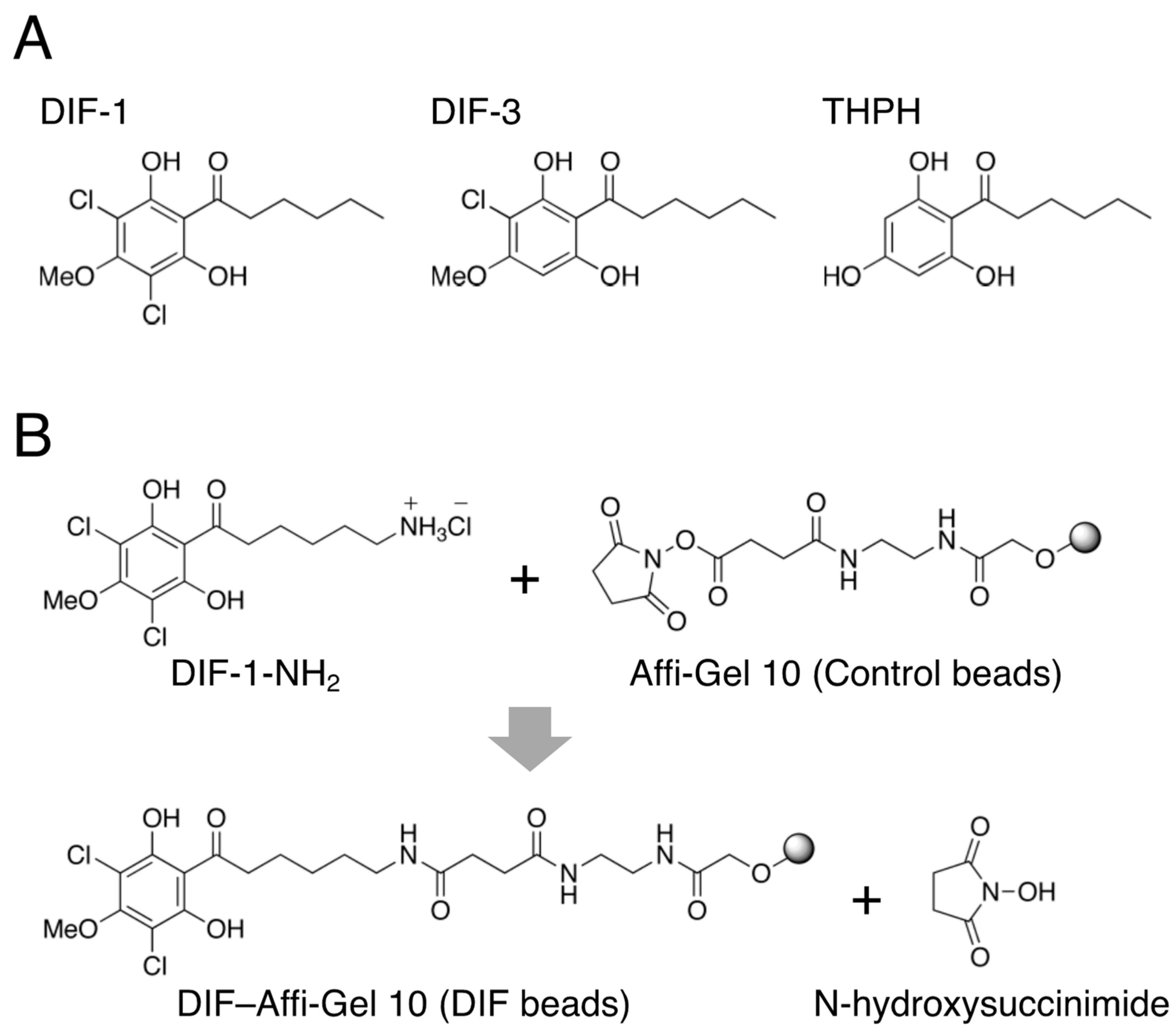
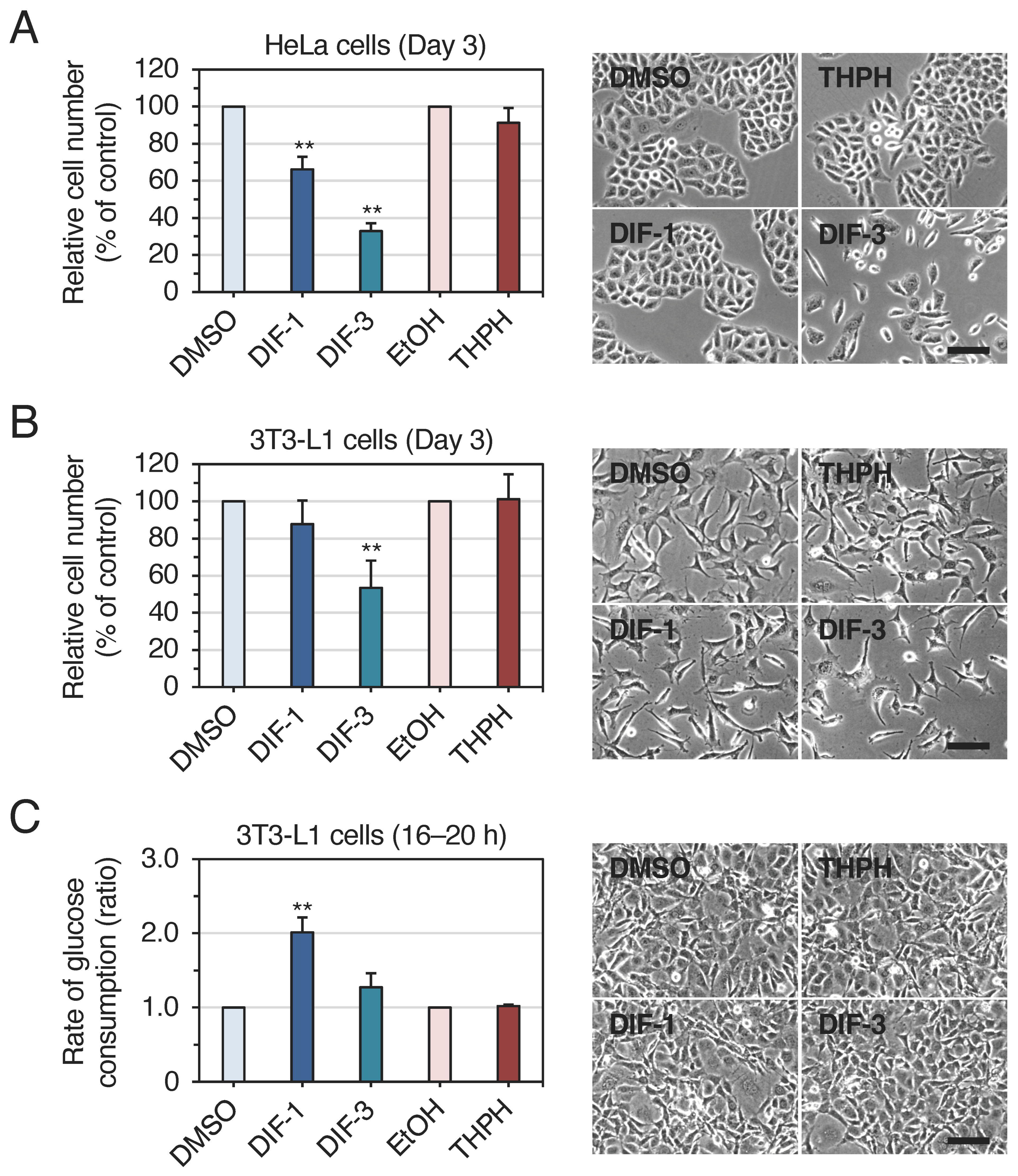
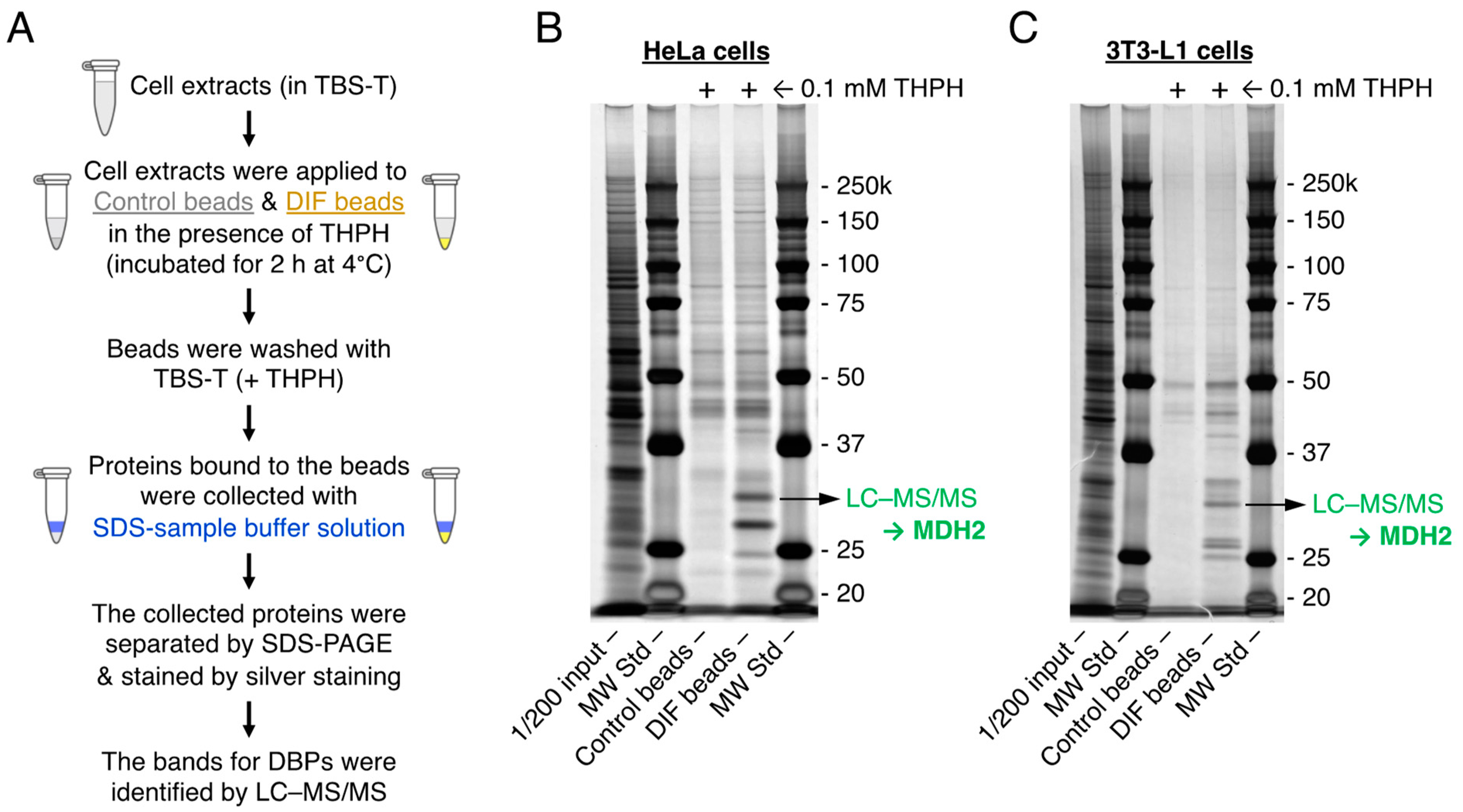
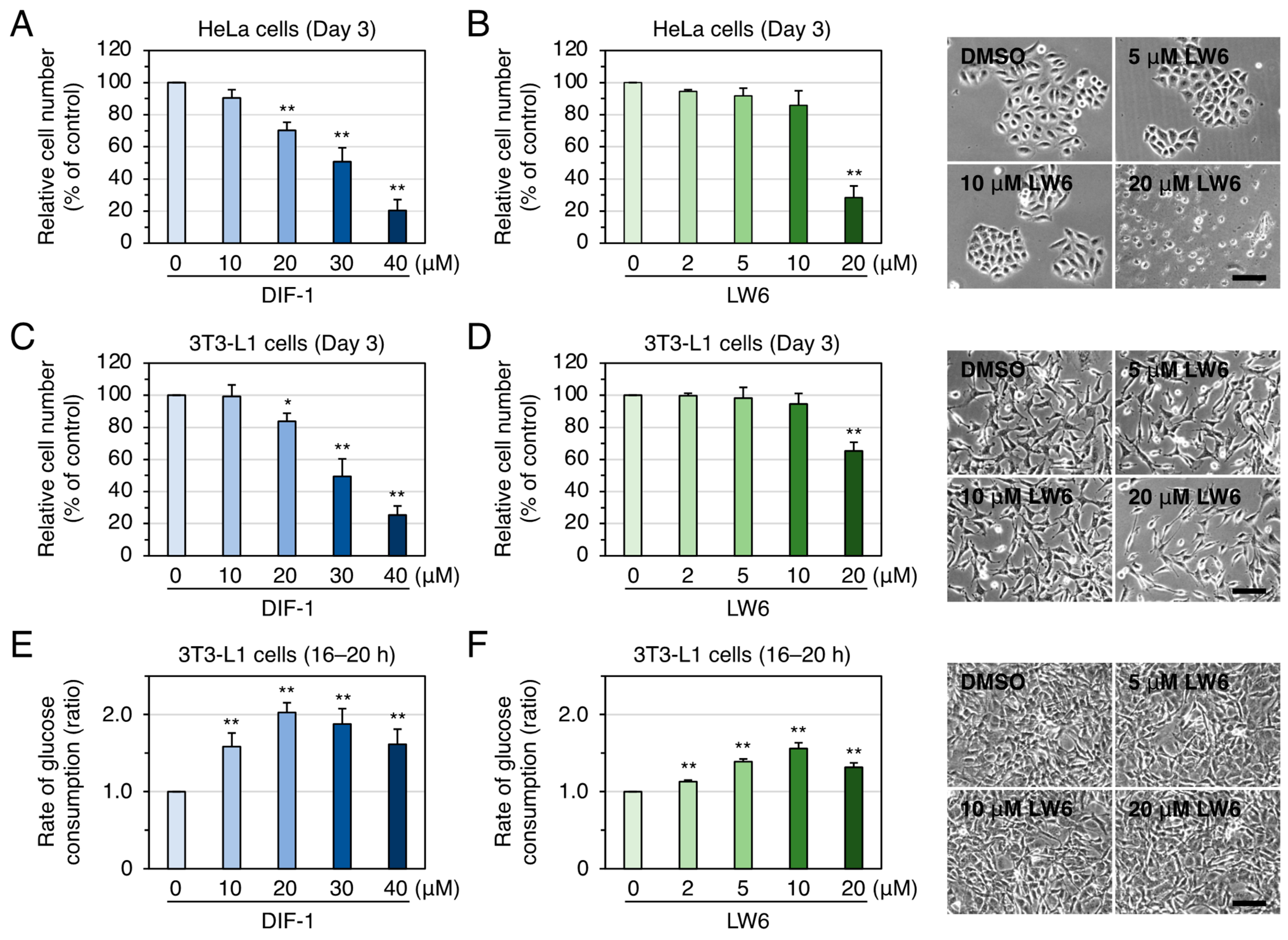
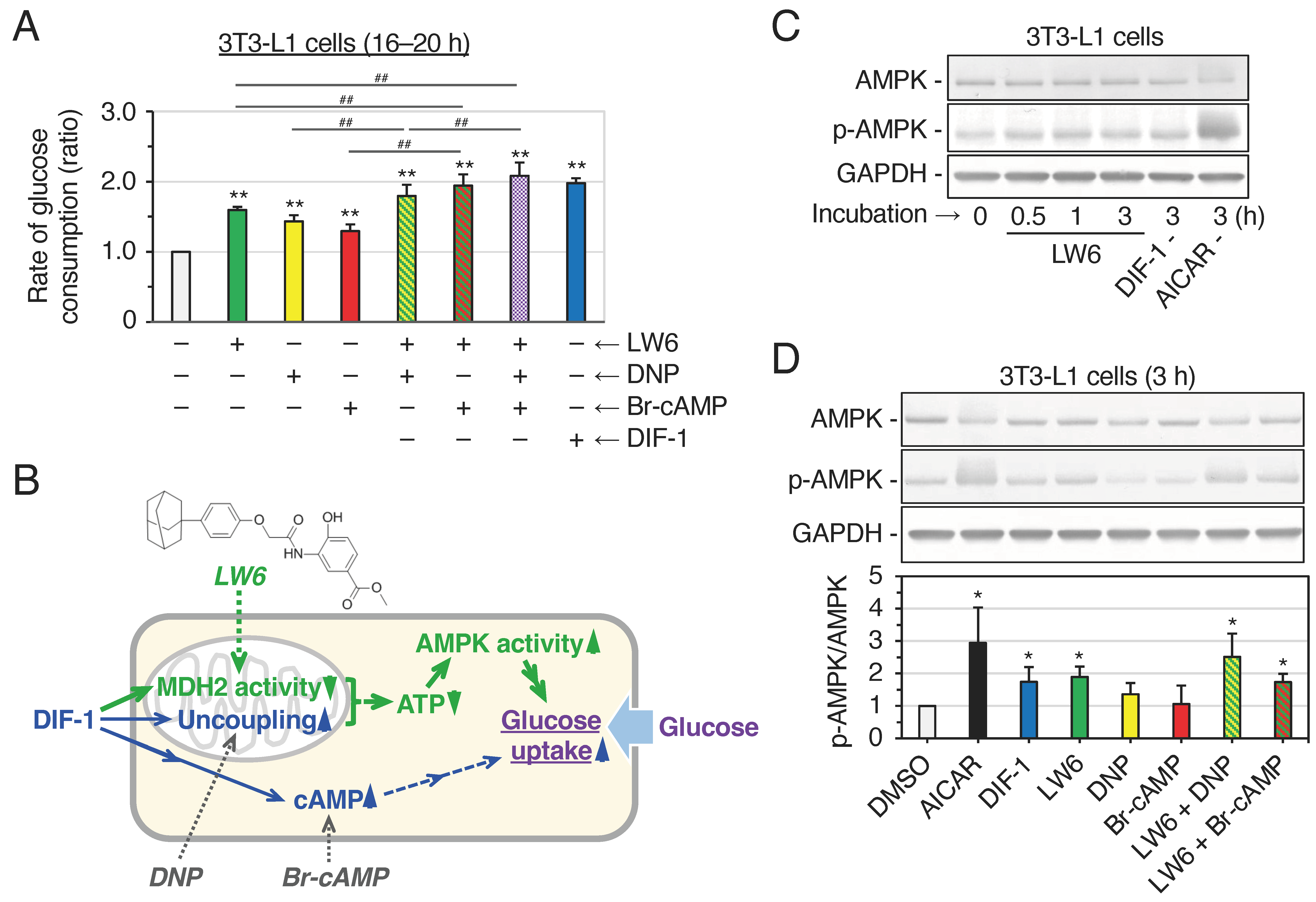
| Compound (Concentration) | Growth Inhibition * | Glucose-Uptake Promotion * | MDH2 Inhibition |
|---|---|---|---|
| DIF-1 (20 μM) | ± | ++ | + ** |
| DIF-3 (20 μM) | + | ± | – ** |
| LW6 (10 μM) | – | + | ++ *** |
Disclaimer/Publisher’s Note: The statements, opinions and data contained in all publications are solely those of the individual author(s) and contributor(s) and not of MDPI and/or the editor(s). MDPI and/or the editor(s) disclaim responsibility for any injury to people or property resulting from any ideas, methods, instructions or products referred to in the content. |
© 2024 by the authors. Licensee MDPI, Basel, Switzerland. This article is an open access article distributed under the terms and conditions of the Creative Commons Attribution (CC BY) license (https://creativecommons.org/licenses/by/4.0/).
Share and Cite
Kubohara, Y.; Fukunaga, Y.; Shigenaga, A.; Kikuchi, H. Dictyostelium Differentiation-Inducing Factor 1 Promotes Glucose Uptake via Direct Inhibition of Mitochondrial Malate Dehydrogenase in Mouse 3T3-L1 Cells. Int. J. Mol. Sci. 2024, 25, 1889. https://doi.org/10.3390/ijms25031889
Kubohara Y, Fukunaga Y, Shigenaga A, Kikuchi H. Dictyostelium Differentiation-Inducing Factor 1 Promotes Glucose Uptake via Direct Inhibition of Mitochondrial Malate Dehydrogenase in Mouse 3T3-L1 Cells. International Journal of Molecular Sciences. 2024; 25(3):1889. https://doi.org/10.3390/ijms25031889
Chicago/Turabian StyleKubohara, Yuzuru, Yuko Fukunaga, Ayako Shigenaga, and Haruhisa Kikuchi. 2024. "Dictyostelium Differentiation-Inducing Factor 1 Promotes Glucose Uptake via Direct Inhibition of Mitochondrial Malate Dehydrogenase in Mouse 3T3-L1 Cells" International Journal of Molecular Sciences 25, no. 3: 1889. https://doi.org/10.3390/ijms25031889
APA StyleKubohara, Y., Fukunaga, Y., Shigenaga, A., & Kikuchi, H. (2024). Dictyostelium Differentiation-Inducing Factor 1 Promotes Glucose Uptake via Direct Inhibition of Mitochondrial Malate Dehydrogenase in Mouse 3T3-L1 Cells. International Journal of Molecular Sciences, 25(3), 1889. https://doi.org/10.3390/ijms25031889






